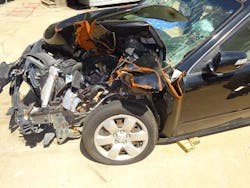University of Extrication: Dash & Instrument Panel Entrapment
Topic: Dash roll or dash jacking evolution
Objective: Given an acquired vehicle to work with, the rescue team will better and successfully complete each step of the F-I-A-T procedure for dash rolling or dash jacking.
Task: Using rescue tools and equipment provided by the department, the rescue team will be able to complete the F-I-A-T procedure on an acquired vehicle and accomplish a successful dash rolling or dash jacking evolution.
Significant changes are taking place in the structure of modern vehicles (the vehicle’s anatomy) that are challenging rescue personnel in new ways. When a hard-impact, head-on collision traps a front occupant and crews want to complete either a dash-rolling or a dash-jacking task, there are now a few modifications that need to be added to the process to get this task done in the most efficient manner.
With this in mind, crews should become familiar with the F-I-A-T acronym to better remember the recommended steps of the dash entrapment procedure, especially on newer models that have the most significant structural changes in the area of the vehicle we will be working on. Not to be confused with the Fiat model of a car, F-I-A-T is an acronym to help crews remember four important points as they complete their dash tasks.
So, what does F-I-A-T stand for?
- F: The “F” stands for Fender, which must be moved to expose what is underneath.
- I: The “I” is for stored gas Inflators that may be nearby your cutting or ramming area.
- A: The “A” is for A-pillar cuts. Both the upper A-pillar and the lower A-pillar areas get cut.
- T: The “T” is for Tie-down, meaning the one or two metal supports that secure the dash structure to the floor of the vehicle.
The F-I-A-T procedure
Once a crew has decided to roll or jack the dash to free a trapped occupant, start with “F” and move or remove the damaged fender. Structural changes in the lower A-pillar and the upper rail components of late-model vehicles are too unpredictable in their design or structure to work with without being able to see them.
Use a power spreader, or whatever tool you have available to work with, and get the crushed and crumpled fender out of the way. It does not have to be removed; just move it enough that you can see and have access to the lower A-pillar and the upper rail. This will allow the crew to be much more efficient at working to defeat this structure and getting the dash to move away from the trapped occupant.
The “I” in the second step of the F-I-A-T dash-rolling or dash-jacking protocol is for inflator. There is a possibility that a stored gas inflator for an airbag system could lie right where the team will be working to complete the dash assignment. Several models of BMW and Mercedes-Benz vehicles, for example, have the stored gas inflator for their roof airbags bolted to each A-pillar at or slightly below the instrument panel.
In addition to the roof bag inflators, the stored gas inflator unit for a driver or front passenger kneebag system may also be in the vicinity of where the pillar cutting or dash pushing will take place. These supplemental restraint systems are designed to deploy in a frontal collision and may remain undeployed in a side impact crash. In either case, rescuers need to check for these inflators as part of the dash rescue process.
Next month
In this article, we have examined the first two steps in the F-I-A-T procedure. In Part 2, we will look at the final two steps. Use the F-I-A-T procedure on the new model vehicles of today and the future. You’ll be glad you did!
About the Author
Ron Moore
RON MOORE, who is a Firehouse contributing editor, recently retired as a division chief with the McKinney, TX, Fire Department and now serves with Prosper, TX, Fire Rescue. He self-published the Vehicle Rescue 1-2-3 training manual and serves as the forum moderator for the extrication section of Firehouse.com . Moore can be contacted directly at [email protected].

